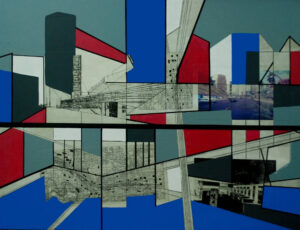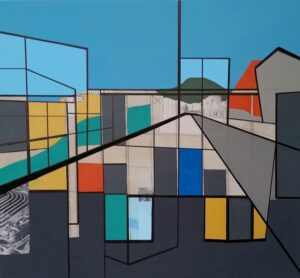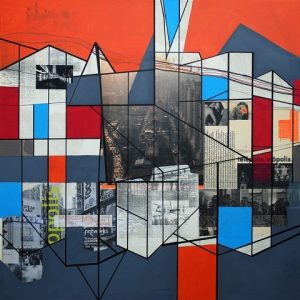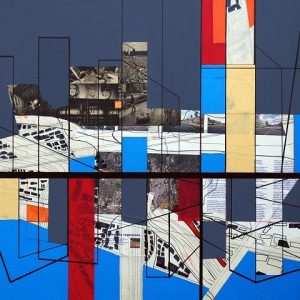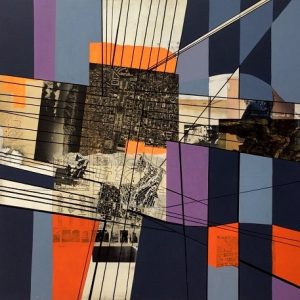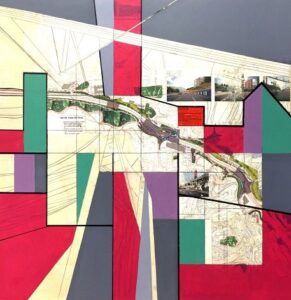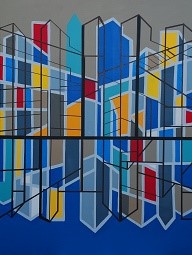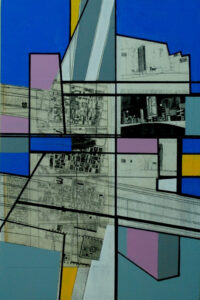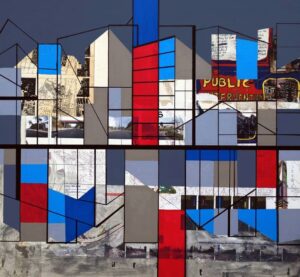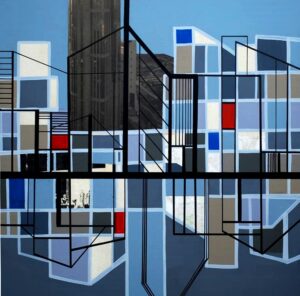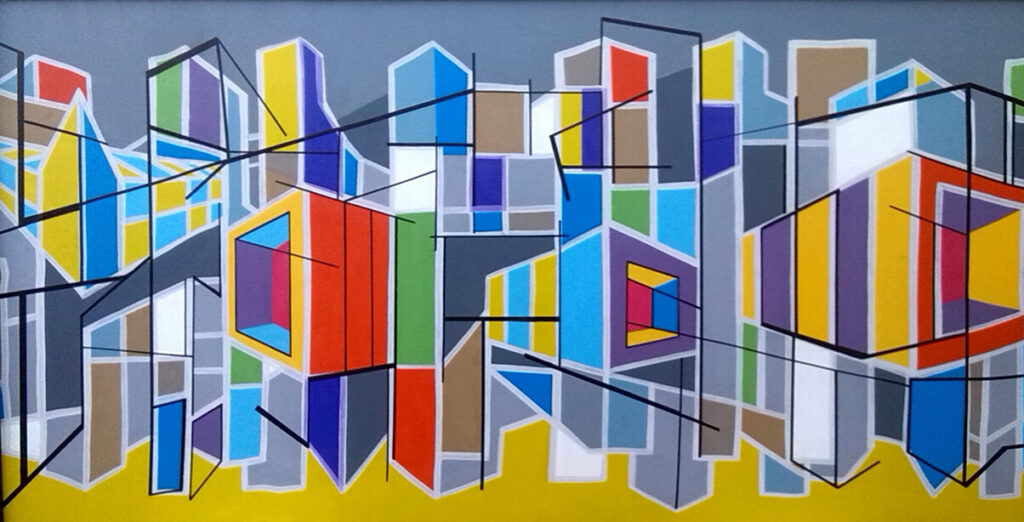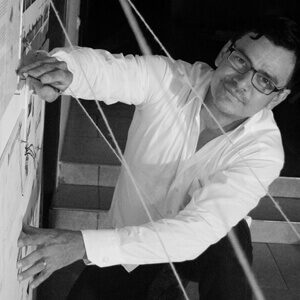
I explore a range of forms and chromatic arrangements that incorporate the influences of architectural agglomerations, thus reinterpreting aerial views, plans and urban skins, as well as fragments and assemblages that fold and unfold through different structures.
These lines/structures that involve space, not only two-dimensionally but three-dimensionally, are incorporated into the environment that contains them, tracing new relationships in the design of these enclosures. I am particularly interested in the evidence of the graphic media, collage, drawing, and painting with which I work, to focus or blur depth, and thus create a feeling of three-dimensionality on a flat surface.
“My works are an aesthetic approach to the problems of contemporary man and the city that he inhabits and builds. This city is a heterogeneous space of places and memories that are of vital importance in the construction and deconstruction of the urban imaginary.”
Raúl Herrera—-
Barinas, Venezuela
Untitled
From the Geo-structures Series
2019
Mixed on Canvas
15 x 21 Inches
US$ 450
Contact Us
Untitled
From the Geo-structures Series
2019
Mixed on Canvas
15 x 21 Inches
US$ 450
Contact Us
On the Helicoid
From the Geo-structures Series
2019
Mixed on Canvas
29 x 31 Inches
US$ 900
Contact Us
On the rock Tarpeya
From the Geo-structures Series
2017
Mixed on DMF
31 x 31 Inches
US$ 900
Contact Us
Untitled
From the Geo-structures Series
n/d
Mixed on MDF
31 x 31 Inches
US$ 900
Contact Us
Untitled
From the Geo-structures Series
n/d
Mixed on MDF
35 x 35 Inches
●
Contact Us
Untitled
From the Geo-structures Series
n/d
Mixed on MDF
35 x 35 Inches
●
Contact Us
Untitled
From the Geo-structures Series
n/d
Mixed on MDF
31 x 31 Inches
●
Contact Us
Structure of the Polis Series
2018
Acrylic on Canvas
36 x 25 inches
●
Contact Us
Untitled
From the Geo-structures Series
2019
Mixed on MDF
17 x 12 Inches
US$ 400
Contact Us
Untitled
From the Geo-structures Series
n/d
Mixed on MDF
31 x 35 Inches
●
Contact Us
Temporary tunnels
Structure of the Polis Series
2018
Acrylic on Canvas
35 x 66 Inches
US$ 1200
Contact Us
Raúl Herrera
RAÚL HERRERA
Born in Venezuela. 1980
Raúl Herrera, was born in Barinas, Venezuela, in 1980. He studied Graphic Arts at the Rafael Calvo Municipal Art Workshop in Barinas, from 1992 to 1998. He holds a BA in Plastic Arts with Graphic Arts Mention “Armando Reverón” from the Institute for Higher Studies of Plastic Arts (IUESAPAR), Caracas,where he gradauated in 2004. He lives and works betwen Barinas and Caracas.
Click below to download full CV

Statement
The Polis: Planes and Skins.
The Polis: Planes and Skins
Structural lines of the urban environment
The image of the city is a heterogeneous space of places and memories that are of vital importance in the construction of contemporary life. I start from this premise and walk through the urban dermis, developing an artistic proposal framed in a discourse referring to the city, which addresses the visual and narrative power of color, shapes, and the various dialogues between the graphic and the random. I am interested in serial forms, where the surface influences our perception of the spatial superpositions that it contains.
I explore a range of forms and chromatic arrangements that incorporate the influences of architectural agglomerations, thus reinterpreting aerial views, plans and urban skins, as well as fragments and assemblages that fold and unfold through different structures. These lines/structures that involve space, not only two-dimensionally but three-dimensionally, are incorporated into the environment that contains them, tracing new relationships in the design of these enclosures. I am particularly interested in the evidence of the graphic media, collage, drawing, and painting with which I work, to focus or blur depth, and thus create a feeling of three-dimensionality on a flat surface.
This city as transit and deployment becomes performance and displacement: routes that are made up of the human’s essence. The concept of heterogeneous, both in its epidermal or physical, and operational sense, functions as a multiplier agent of opposing and confronting visions, and paradoxes of an urban reality that can be either totally beneficial as a representation of development and beauty, or completely perverse as an event of chaos, of debauchery, ugliness, and destitution; a mirror/duality that corresponds to the configuration of the contemporary city in the origins of urbanism. This exploration, mostly existential, of the city’s iconography through its dynamic folds and unfolds, transforms and molds the human soul, evidencing or registering the city’s social complexity, and turns it into an aesthetic and conceptual response.
Alberto Asprino
Curator
The City as an Existential Extension of Being
Raúl Herrera
“Cities have the capability of providing something for everybody, only because, and only when, they are created by everybody”
-. Jane Jacobs (1916-2006)
The city as an existential extension of being, has been repeatedly interpreted by visual creators since time immemorial, allowing us, somehow, to be eyewitnesses of its own evolution and development, of its social and architectural complexities, and of its transformation as the epicenter of existence.
A city built from art is ultimately a refuge for those who inhabit it, for those who interpret it as an experiential document, and for those who come to it from an emotional point of view.
Raul Herrera (Barinas, 1980) brings us closer to the city from a frontal, blurred perspective, transforming it into a sort of urban facade that turns the plan into space, accent, and architectural construction.
His structures are configured from his own experiences, those that move between the city itself and the peripheral territory of the artist’s native geography. They are habitable structures that enclose and contain the emotional landscape that occupies them, runs through them, and recreates them as imaginary and contemplative.
The artist creates geometric structures full of a deep chromatic load that transforms them into silent spaces, charged with light, and with a life of their own; pictorial structures where line, plan, and color reside. They contain a condition that transforms everything and consolidates the act of living and transcending.
From a creator and meticulous observer spirit, Herrera assembles everything that passes through his gaze, turning the ideal of the city into what we all in some way aspire: a map and refuge for our best human values.

